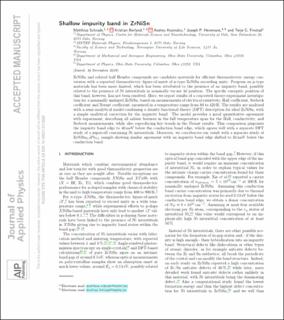Shallow Impurity Band in ZrNiSn
Peer reviewed, Journal article
Accepted version
Permanent lenke
https://hdl.handle.net/11250/2684339Utgivelsesdato
2020Metadata
Vis full innførselSamlinger
- Publikasjoner fra CRIStin - SINTEF AS [5801]
- SINTEF Industri [1565]
Originalversjon
10.1063/1.5112820Sammendrag
ZrNiSn and related half Heusler compounds are candidate materials for efficient thermoelectric energy conversion with a reported thermoelectric figure-of-merit of n-type ZrNiSn exceeding unity. Progress on p-type materials has been more limited, which has been attributed to the presence of an impurity band, possibly related to Ni interstitials in a nominally vacant 4d position. The specific energetic position of this band, however, has not been resolved. Here, we report the results of a concerted theory-experiment investigation for a nominally undoped ZrNiSn, based on the electrical resistivity, the Hall coefficient, the Seebeck coefficient, and the Nernst coefficient, measured in a temperature range from 80 to 420 K. The results are analyzed with a semianalytical model combining a density functional theory (DFT) description for ideal ZrNiSn, with a simple analytical correction for the impurity band. The model provides a good quantitative agreement with experiment, describing all salient features in the full temperature span for the Hall, conductivity, and Seebeck measurements, while also reproducing key trends in the Nernst results. This comparison pinpoints the impurity band edge to 40 meV below the conduction band edge, which agrees well with a separate DFT study of a supercell containing Ni interstitials. Moreover, we corroborate our result with a separate study of the ZrNiSn0.9Pb0.1 sample showing similar agreement with an impurity band edge shifted to 32 meV below the conduction band.
